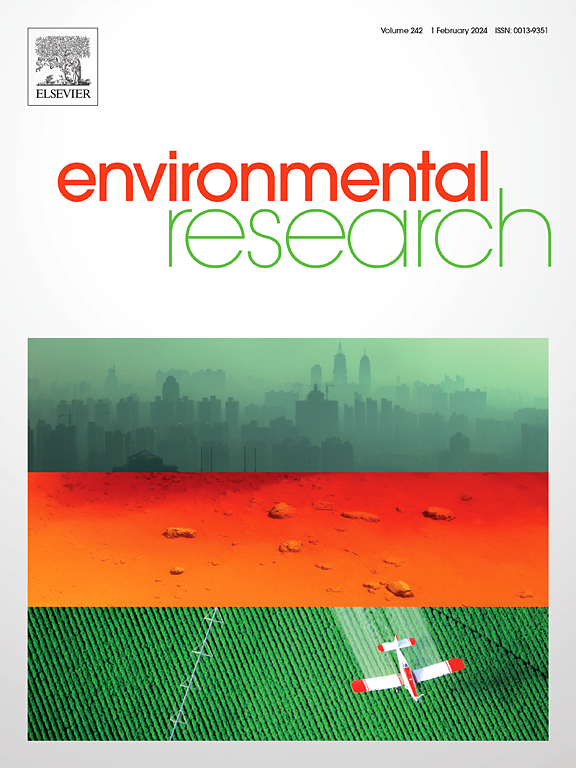北极海洋沉积物中的微塑料颗粒:共同的来源还是共同的过程?
IF 7.7
2区 环境科学与生态学
Q1 ENVIRONMENTAL SCIENCES
引用次数: 0
摘要
塑料消费正在增加,每年有数百万吨塑料被排放到海洋中。塑料物质正在海洋环境中积累,特别是在海底。北极被塑料污染了,包括微塑料(MPs, 5毫米),但发生的情况、浓度和命运在很大程度上是未知的。这项研究旨在评估MPs是否在巴伦支海更大的水深处积聚,并靠近朗伊尔城定居点,并了解一种特定类型的收集颗粒的普遍性和来源。在斯瓦尔巴群岛周围的7个站点用箱盖收集地表沉积物,每个站点进行3次重复。通过饱和盐水密度分离提取MPs。发现了许多颗粒,并通过热解- gc /MS对其成分进行了测定。程序空白使用现场空白作为样本来评估总体污染。然后用μ拉曼光谱分析了所有提取粒子的组成。平均为3.61±1.45 MPs/100 g (dw)。空白校正后,海冰站的污染程度更严重,呈现出与其他站不同的剖面,而最深的海冰站并没有显示出最高的MP浓度,而是相反。靠近朗伊尔城的沉积物也没有比其他站点受到更严重的污染。在所有站点都发现了类似的黑色颗粒,这提出了一个可能的共同来源或过程的问题。这些颗粒由几种塑料聚合物制成,每种颗粒的比例各不相同,这表明这些颗粒的起源有一个共同的过程,可能是海洋雪的形成。本文章由计算机程序翻译,如有差异,请以英文原文为准。

Microplastic pellets in Arctic marine sediments: a common source or a common process?
Plastic consumption is increasing, and millions of tonnes of plastic are released into the oceans every year. Plastic materials are accumulating in the marine environment, especially on the seafloor. The Arctic is contaminated with plastics, including microplastics (MPs, <5 mm) but occurrences, concentrations and fate are largely unknown. This study aimed at assessing whether MPs accumulate at greater water depths in the Barents Sea, and close to the Longyearbyen settlement, and at understanding the ubiquity and source of a specific type of collected pellets. Surface sediments were collected at seven stations around Svalbard with a box-corer, and three replicates were taken at each station. MPs were extracted through density separation with saturated saltwater. Many pellets were found, and their composition was assessed by pyrolysis-GC/MS. Procedural blanks were performed using field blanks as samples to assess the overall contamination. The composition of all extracted particles was then analysed by μRaman spectroscopy. On average, 3.61 ± 1.45 MPs/100 g (dw) were found. The sea ice station, after blank correction, was more contaminated and displaying a different profile than the other stations, and the deepest station did not show the highest MP concentrations but rather the opposite. Sediments close to Longyearbyen were not more contaminated than the other stations either. Dark pellets of similar aspect were found at all stations, raising the question about a possible common source or process. These pellets were made of several plastic polymers which varied in proportion for each pellet, suggesting a common process was at the origin of those pellets, potentially marine snow formation.
求助全文
通过发布文献求助,成功后即可免费获取论文全文。
去求助
来源期刊

Environmental Research
环境科学-公共卫生、环境卫生与职业卫生
CiteScore
12.60
自引率
8.40%
发文量
2480
审稿时长
4.7 months
期刊介绍:
The Environmental Research journal presents a broad range of interdisciplinary research, focused on addressing worldwide environmental concerns and featuring innovative findings. Our publication strives to explore relevant anthropogenic issues across various environmental sectors, showcasing practical applications in real-life settings.
 求助内容:
求助内容: 应助结果提醒方式:
应助结果提醒方式:


